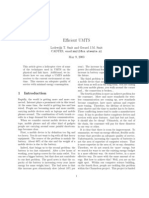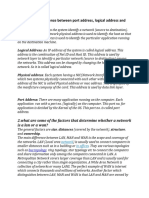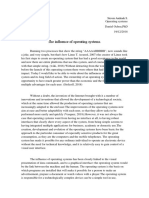GSM Analysis Lab Exercise
GSM Analysis Lab Exercise
Uploaded by
Dramane BonkoungouCopyright:
Available Formats
GSM Analysis Lab Exercise
GSM Analysis Lab Exercise
Uploaded by
Dramane BonkoungouOriginal Description:
Original Title
Copyright
Available Formats
Share this document
Did you find this document useful?
Is this content inappropriate?
Copyright:
Available Formats
GSM Analysis Lab Exercise
GSM Analysis Lab Exercise
Uploaded by
Dramane BonkoungouCopyright:
Available Formats
David Gundlegrd & Sara Modarres Razavi LiTH KTS
2011
Lab Exercise 1: TNK093 Mobile Communication
Exploring Cellular Networks using Ericsson TEMS Investigation
Preparation:
Introduction
Ericsson TEMS Investigation is a state-of-the-art tool when it comes to cellular network testing and troubleshooting. It is frequently used by network planners, network developers and researchers in order to get detailed information about the network performance. There are hundreds of possible functions to explore in TEMS Investigation, however, in this course we will start by getting familiar with the program and hopefully obtain a better understanding of cellular network design and characteristics. In the lab you will explore trace files from the GSM and UMTS networks. The trace files are collected by a Sony-Ericsson Z750i and a GPS receiver. The lab is divided into two parts; the first part relates to general information about the different networks and the second part focuses on network signaling.
Open logfile
Signaling Map
Figure 1: Data collection page in TEMS.
Opening and viewing the logfiles First, open the logfile, then press the play button and let the logfile finish. Expand the Presentation and Positioning folders to the left and double-click on the map icon in order to show the logged events on the map (Figure 1).
David Gundlegrd & Sara Modarres Razavi LiTH KTS
2011
Start by looking at the logfiles GSM_speech.log, UMTS_speech.log. If you click in the WCDMA/GSM Line Chart window, you can choose where in the file you want to look (use the arrow keys to move around). Expand the Signaling folder to the left, double-click on Layer 3 Messages and have a brief look at the signalling messages that are sent.
General
Look at the GSM_speech.log:
1.1 Where is the location where the logfile is taken from? 1.2 What happens in the logfile in terms of phone calls, SMS, updates, etc.? 1.3 What is the Mobile Country Code? 1.4 What is the Mobile Network Code? 1.5 What is the Location Area Code? 1.6 What is the Cell ID that is used when the MS is first connected to the network? 1.7 What is the RF channel number (ARFCN) that is used when the MS is first connected to the network? 1.8 Does the RF channel number change during the connection? 1.9 What frequency band is used? 1.10 Does it change during the connections?
Look at the UMTS_speech.log:
2.1 Where is the location where the logfile is taken from? 2.2 What happens in the logfile in terms of phone calls, SMS, updates, etc.? 2.3 What is the Mobile Country Code? 2.4 What is the Mobile Network Code? 2.5 What is the Location Area Code? 2.6 What is the Cell ID that is used when the MS is first connected to the network? 2.7 What is the RF channel number (ARFCN) that is used when the MS is first connected to the network? 2.8 Does the RF channel number change during the connection? 2.9 What frequency band is used? 2.10 Does it change during the connections? (Hint: use Google to solve the question)
In the Templates folder to the left, double click the Line Chart Template. Right click in the window and Properties to edit Chart 1. In this dialogue box you can add the information elements that you want to plot in the line chart diagram. This plot function can be used to solve coming lab exercises. In this case choose the information elements MS Tx-Power and TA.
3.1 Are these two variables correlated in theory? 3.2 Can you identify any correlation between them? 3.3 How would you explain that?
Network Signaling
Open and run the GSM_speech.log file again and switch to the signalling window using the lower signaling button (next to the overview button).
4.1 Determine the P-TMSI/TMSI- number of the cell phone.
Look at the broadcast messages sent by the base station.
5.1 What is the Cell ID? 5.2 What is the LA update RxLev hysteresis? 5.3 What is the purpose of the LA update RxLev hysteresis?
David Gundlegrd & Sara Modarres Razavi LiTH KTS
2011
The cell neighbour lists are sent by the BTS in the messages System Information Type 5 (GSM 900) and System Information Type 5ter (GSM 1800).
6.1 Determine the number of neighbours that are broadcast by the base station. 6.2 Determine the number of neighbours that the MS typically sends reports about. (Hint: Look at a number of Measurement Report messages) 6.3 Find the messages related to an LA update? 6.4 Describe the purpose of the channel request and immediate assignment messages. 6.5 What logical channels are used for those messages?
Look at the SMS.log:
7.1 Where is the location where the logfile is taken from? 7.2 What happens in the logfile in terms of phone calls, SMS, updates, etc.? 7.3 Are there any paging messages sent to our cell phone? 7.4 Are there any paging messages sent to other cell phones? 7.5 Are these cell phones necessarily in the same cell? 7.6 How does the cell phone distinguish which messages that it should respond to? 7.7 Can you find the text that is sent in the SMS messages? 7.8 Are there any measurement reports sent during the SMS reception? 7.9 In that case, which logical channel is used? 7.10 Is there any other SMS in the logfile?
You might also like
- Argumentative Essay - The Pros and Con of Cell PhonesDocument7 pagesArgumentative Essay - The Pros and Con of Cell PhonesAlexis Dixon100% (1)
- Telecom Interview Questions Answers Guide PDFDocument10 pagesTelecom Interview Questions Answers Guide PDFAkhtar Khan0% (1)
- STS Chapter 3 Lesson 4Document6 pagesSTS Chapter 3 Lesson 4Gino Dijeto Soles50% (2)
- Lab 3Document2 pagesLab 3Hamm MmadNo ratings yet
- Lab Exercise 2: TNK093 Mobile Communication - Radio Resource/Link ControlDocument2 pagesLab Exercise 2: TNK093 Mobile Communication - Radio Resource/Link Controlcorneliu.modilcaNo ratings yet
- GSM SignalDocument62 pagesGSM Signalitzme1No ratings yet
- An Overview of The GSM SystemDocument32 pagesAn Overview of The GSM System0796105632No ratings yet
- CNP 9802Document6 pagesCNP 9802K Peng TanNo ratings yet
- Mobile Phone How It WorksDocument8 pagesMobile Phone How It WorksVijay Chowdary DasariNo ratings yet
- Forensics and The GSM Mobile Telephone System: International Journal of Digital Evidence Spring 2003, Volume 2, Issue 1Document17 pagesForensics and The GSM Mobile Telephone System: International Journal of Digital Evidence Spring 2003, Volume 2, Issue 1BEALogicNo ratings yet
- Telecommunication Protocols Questions and AnswersDocument3 pagesTelecommunication Protocols Questions and AnswersHitesh ShastryNo ratings yet
- InvestigationDocument5 pagesInvestigationkisvishalNo ratings yet
- Introduction To GSM, The Global System For Mobile Communication 1. Introduction: The Evolution of Mobile Telephone SystemsDocument9 pagesIntroduction To GSM, The Global System For Mobile Communication 1. Introduction: The Evolution of Mobile Telephone SystemsMaulin AminNo ratings yet
- Jamming LTE Signals: Rafał Krenz, Soumya BrahmaDocument5 pagesJamming LTE Signals: Rafał Krenz, Soumya BrahmasjzurekNo ratings yet
- What Is OSI Model?Document7 pagesWhat Is OSI Model?nupoorhit2126No ratings yet
- Entities of The GSM SystemDocument18 pagesEntities of The GSM Systemhieuvnp3No ratings yet
- Mobile Computing: Sixth Semester Diploma Examination in Engineering/Technology-MARCH, 2014Document17 pagesMobile Computing: Sixth Semester Diploma Examination in Engineering/Technology-MARCH, 2014Midhun CMNo ratings yet
- Assignment - EE4105Document6 pagesAssignment - EE4105Dilshini JayamahaNo ratings yet
- How Mobile Phone WorksDocument7 pagesHow Mobile Phone WorksRoxzen Valera ColladoNo ratings yet
- Multimedia Messaging Service Front End For Supplementary Messaging ServicesDocument38 pagesMultimedia Messaging Service Front End For Supplementary Messaging ServicesjodoteeNo ratings yet
- Evolved Packet System (EPS), While The Acronym LTE Refers Only To The EvolutionDocument14 pagesEvolved Packet System (EPS), While The Acronym LTE Refers Only To The EvolutionkiranmannNo ratings yet
- Mobile CommunicationsDocument31 pagesMobile Communicationssuid111100% (1)
- Chapter 1 Introduction To Wireless Communication SystemsDocument2 pagesChapter 1 Introduction To Wireless Communication SystemsPuja Kusuma50% (2)
- Tems Visualization PDFDocument8 pagesTems Visualization PDFWibowo AriNo ratings yet
- Module 5Document61 pagesModule 5mahendra naikNo ratings yet
- Basic TechnologyDocument21 pagesBasic Technologyajetunmobi ayodejiNo ratings yet
- Generations of Network: 1G, 2G, 3G, 4G, 5G: First Generation (1G) - Analog SystemDocument20 pagesGenerations of Network: 1G, 2G, 3G, 4G, 5G: First Generation (1G) - Analog Systemhoiyen92No ratings yet
- Lecture 2 - Modeling of Signaling Systems and Historical Examples in PSTNDocument17 pagesLecture 2 - Modeling of Signaling Systems and Historical Examples in PSTNGigi IonNo ratings yet
- Communication SystemDocument9 pagesCommunication SystemNouman BajwaNo ratings yet
- Call Setup in A GSM NetworkDocument6 pagesCall Setup in A GSM NetworkluvdembadNo ratings yet
- Mobile Computing Suggession - GNITDocument15 pagesMobile Computing Suggession - GNITatik palNo ratings yet
- Smit 03 EfficientDocument6 pagesSmit 03 EfficientAsitha DharmadasaNo ratings yet
- Design and Testing of A Mobile-Phone-Jammer: July 2016Document13 pagesDesign and Testing of A Mobile-Phone-Jammer: July 2016Deny PrayogaNo ratings yet
- LTE Jamming v6Document6 pagesLTE Jamming v6ABDULHADI AL AHMADNo ratings yet
- Network ArchitectureDocument10 pagesNetwork ArchitectureTri NguyenNo ratings yet
- Digit AnalysisDocument50 pagesDigit Analysisesther_kakani2029100% (1)
- Acn PDFDocument4 pagesAcn PDFmaldiniNo ratings yet
- GSM Base PaperDocument5 pagesGSM Base PaperveeraNo ratings yet
- (T) - (T) (F) (T) (F) (T) (T) (F) (T) (T) (T) (T) (T) (F) (F) (F) (F) (T) (T) (T) (F) (F) (F) (F) (T) (T)Document15 pages(T) - (T) (F) (T) (F) (T) (T) (F) (T) (T) (T) (T) (T) (F) (F) (F) (F) (T) (T) (T) (F) (F) (F) (F) (T) (T)api-26050323No ratings yet
- 3GPP TS 22.090Document9 pages3GPP TS 22.090santanameroNo ratings yet
- Introduction To GSMDocument9 pagesIntroduction To GSMSandeep VermaNo ratings yet
- Design and Testing of A Mobile-Phone-Jammer: July 2016Document13 pagesDesign and Testing of A Mobile-Phone-Jammer: July 2016vamsiNo ratings yet
- Mobility and Security Management in The GSM System and Some Proposed Future ImprovementsDocument18 pagesMobility and Security Management in The GSM System and Some Proposed Future Improvementstanmoy720No ratings yet
- Section OneDocument53 pagesSection OneRock DolphinNo ratings yet
- IT-702 WMC Assignment Unit 1: Q.N o Questions MarksDocument3 pagesIT-702 WMC Assignment Unit 1: Q.N o Questions MarksamaniNo ratings yet
- Mobile Phone TechnologiesDocument9 pagesMobile Phone TechnologiesMUKISA PHILICAYSNo ratings yet
- Ece QuestionsDocument6 pagesEce QuestionsArockia RajNo ratings yet
- Data Communication and Network Chapter 1Document7 pagesData Communication and Network Chapter 1Alia NadzirahNo ratings yet
- Telecomhall: Get Google ChromeDocument18 pagesTelecomhall: Get Google ChromeARe ZYmNo ratings yet
- Part-A (University Questions) : Sengunthar College of Engineering, TiruchengideDocument24 pagesPart-A (University Questions) : Sengunthar College of Engineering, TiruchengideAlwarsamy RamakrishnanNo ratings yet
- Presentation Objectives: Introduction To GSM Learning About GSM Network ArchitectureDocument13 pagesPresentation Objectives: Introduction To GSM Learning About GSM Network ArchitectureronyiutNo ratings yet
- 3GPP TS 22.090Document9 pages3GPP TS 22.090santanameroNo ratings yet
- NFC AbstractDocument21 pagesNFC AbstractSaqib AmeenNo ratings yet
- 3rd Generation Partnership Project Technical Specification Group Terminals Alphabets and Language-Specific Information (3G TS 23.038 Version 3.1.0)Document20 pages3rd Generation Partnership Project Technical Specification Group Terminals Alphabets and Language-Specific Information (3G TS 23.038 Version 3.1.0)santanameroNo ratings yet
- GSM Brief History:: April 10, 2007 - 7:37 AmDocument14 pagesGSM Brief History:: April 10, 2007 - 7:37 Amnitin254No ratings yet
- Chapter Two-1Document9 pagesChapter Two-1Ashenafi DegafuNo ratings yet
- ss7 UserpartsDocument35 pagesss7 UserpartspriyaspvNo ratings yet
- Computer Network 1st AssignmentDocument3 pagesComputer Network 1st AssignmentRodney AlexanderNo ratings yet
- Uc PDFDocument9 pagesUc PDFchandaranadhruv9No ratings yet
- Grand Viva Question For Ece StudentDocument17 pagesGrand Viva Question For Ece Studentapi-35904739086% (7)
- HUAWEI E397 DatasheetDocument2 pagesHUAWEI E397 DatasheetDramane BonkoungouNo ratings yet
- SIG Compendium 01 Part2Document7 pagesSIG Compendium 01 Part2Dramane BonkoungouNo ratings yet
- Spectral Analysis With RTL-SDR RadioDocument2 pagesSpectral Analysis With RTL-SDR RadioDramane BonkoungouNo ratings yet
- Fresnel Zones and Their EffectDocument3 pagesFresnel Zones and Their EffectDramane BonkoungouNo ratings yet
- Fantasi Usb-2 Asi/Sdi Input+Output Adapter: FeaturesDocument1 pageFantasi Usb-2 Asi/Sdi Input+Output Adapter: FeaturesDramane BonkoungouNo ratings yet
- Dtc-340 Rfxpert: RF Monitoring and Analysis SoftwareDocument1 pageDtc-340 Rfxpert: RF Monitoring and Analysis SoftwareDramane BonkoungouNo ratings yet
- DVBControl BrochureDocument32 pagesDVBControl BrochureDramane BonkoungouNo ratings yet
- Siemens xt75Document2 pagesSiemens xt75Dramane BonkoungouNo ratings yet
- DVBAnalyzer PriceDocument2 pagesDVBAnalyzer PriceDramane Bonkoungou100% (1)
- DTC-320 Stream ExpertDocument1 pageDTC-320 Stream ExpertDramane BonkoungouNo ratings yet
- Nokia Fbus PC ConnexionDocument4 pagesNokia Fbus PC ConnexionDramane BonkoungouNo ratings yet
- DVB-T and SplatDocument6 pagesDVB-T and SplatDramane BonkoungouNo ratings yet
- Nevion DVB Ts MuxDocument4 pagesNevion DVB Ts MuxDramane BonkoungouNo ratings yet
- TSReader Hardware SupportDocument24 pagesTSReader Hardware SupportDramane BonkoungouNo ratings yet
- TSReader Software SupportDocument4 pagesTSReader Software SupportDramane BonkoungouNo ratings yet
- DVB PDH SDH AdapterDocument3 pagesDVB PDH SDH AdapterDramane BonkoungouNo ratings yet
- An Architecture For The Delivery of DVB Services Over IP NetworksDocument9 pagesAn Architecture For The Delivery of DVB Services Over IP NetworksDramane BonkoungouNo ratings yet
- Overview of DVB-TDocument19 pagesOverview of DVB-TDramane BonkoungouNo ratings yet
- Audacity Settings For RecordingDocument4 pagesAudacity Settings For RecordingDramane BonkoungouNo ratings yet
- Matlab Modulation FunctionsDocument2 pagesMatlab Modulation FunctionsDramane BonkoungouNo ratings yet
- Recording and Editing With AudacityDocument3 pagesRecording and Editing With AudacityDramane BonkoungouNo ratings yet
- CHAPTER 1: Introduction To Information and Communications Technology (ICT)Document18 pagesCHAPTER 1: Introduction To Information and Communications Technology (ICT)Haries Vi Traboc MicolobNo ratings yet
- Digital JewelleryDocument25 pagesDigital JewelleryIsha Bhatia100% (1)
- The Influence of Operating SystemsDocument3 pagesThe Influence of Operating SystemsstvnstvnNo ratings yet
- Market Entry Strategies.. Pioneers Versus Late ArrivalsDocument12 pagesMarket Entry Strategies.. Pioneers Versus Late ArrivalsMarlene LeuluaiNo ratings yet
- GSM Phone Anatomy LatestDocument11 pagesGSM Phone Anatomy LatestabhineetkumarNo ratings yet
- Television DebateDocument3 pagesTelevision DebateSarah RowlingNo ratings yet
- Sas Ig 10 Soal + KunciDocument13 pagesSas Ig 10 Soal + KunciAli yusronNo ratings yet
- Noam Shoval, Michal Isaacson - Tourist Mobility and Advanced Tracking Technologies (Routledge Advances in Tourism) (2009)Document228 pagesNoam Shoval, Michal Isaacson - Tourist Mobility and Advanced Tracking Technologies (Routledge Advances in Tourism) (2009)Beatriz Romão100% (1)
- Ebin - Pub Enhanced Radio Access Technologies For Next Generation Mobile Communication 1st Edition 9789048173860 9048173868Document283 pagesEbin - Pub Enhanced Radio Access Technologies For Next Generation Mobile Communication 1st Edition 9789048173860 9048173868Ammar Ikram100% (1)
- Cellular NetworksDocument14 pagesCellular NetworksAli Athar CHNo ratings yet
- Mobile DevicesDocument162 pagesMobile DevicesJakim LopezNo ratings yet
- Current Status of Ict in Nigeria: - "Economic, Social and Legal AspectsDocument26 pagesCurrent Status of Ict in Nigeria: - "Economic, Social and Legal AspectsKingsley 'kingsville' UdofaNo ratings yet
- Polytechnic SMS Result DisseminationDocument75 pagesPolytechnic SMS Result DisseminationAaron KureNo ratings yet
- The Origin of Water: Where Did Earth's Water Come From?Document8 pagesThe Origin of Water: Where Did Earth's Water Come From?Dinesh RawalNo ratings yet
- What Is Empowerment TechnologyDocument2 pagesWhat Is Empowerment TechnologyJo Honey HugoNo ratings yet
- Cat Acc PassatDocument36 pagesCat Acc PassatOvidiuNo ratings yet
- Assignment ON Research Methodology: TopicDocument13 pagesAssignment ON Research Methodology: TopicpandeypriyaNo ratings yet
- Flyer 7948 Mexico Retro GB 0408Document2 pagesFlyer 7948 Mexico Retro GB 0408trhildebrand96No ratings yet
- A Position Paper About Using Cellphone in ClassDocument2 pagesA Position Paper About Using Cellphone in ClassJemima Bantula FelipeNo ratings yet
- Notice Defendants Supplemental Response States ADDocument10 pagesNotice Defendants Supplemental Response States ADkc wildmoonNo ratings yet
- Unit5 Mobile ComputingDocument81 pagesUnit5 Mobile ComputingSanju ShreeNo ratings yet
- Write An Essay Expressing Your Opinion On This Matter of Not Allowing Students To Bring Mobile Phones To SchoolDocument2 pagesWrite An Essay Expressing Your Opinion On This Matter of Not Allowing Students To Bring Mobile Phones To SchoolOscar TeohNo ratings yet
- Bennett Russell 20200428Document45 pagesBennett Russell 20200428cyy122317No ratings yet
- 001 Nokia 810 Contacts Sync Instruction GuideDocument6 pages001 Nokia 810 Contacts Sync Instruction GuideJuan Ramón MartínezNo ratings yet
- 09-12-12 EditionDocument32 pages09-12-12 EditionSan Mateo Daily JournalNo ratings yet
- Pet Care System Based On Android ApplicationDocument4 pagesPet Care System Based On Android ApplicationEditor IJTSRDNo ratings yet
- Usability and Design Issues of Smartphone UserDocument12 pagesUsability and Design Issues of Smartphone UserJulian Ambrose RamirezNo ratings yet
- Horizon Polycom Trio 8500 Full User Guide v1Document33 pagesHorizon Polycom Trio 8500 Full User Guide v1Arifin IpinNo ratings yet














































































































